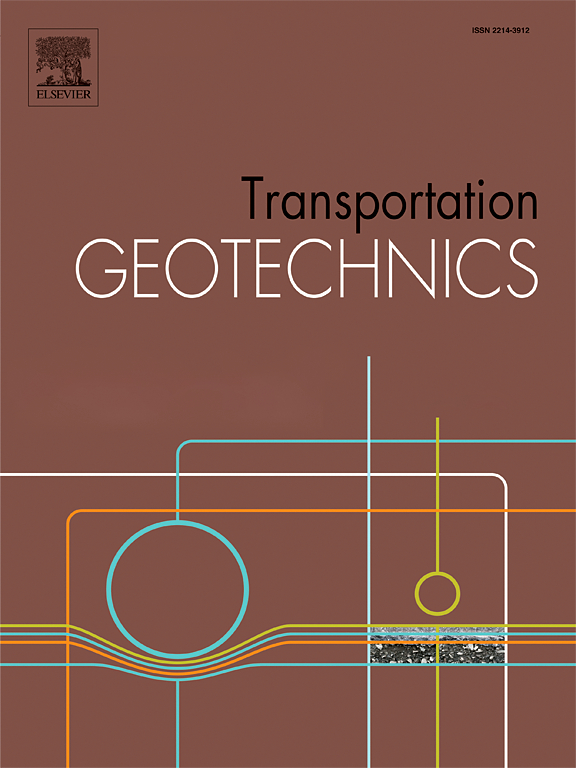评估硅烷处理过的路面基层土壤的冻融性能
IF 4.9
2区 工程技术
Q1 ENGINEERING, CIVIL
引用次数: 0
摘要
硅烷可以有效地限制对路面系统的冻融影响,因为它在基材中产生拒水性,并且可以限制水进入路基土壤。原生冻胀是由孔隙水向冰的相变引起的,次生冻胀是由水从气包带不断向生长的冰透镜流动引起的。因此,限制水从渗透区流入可能是减轻冻融循环对路基土壤有害影响的最有效方法。本研究旨在通过硅烷处理路基土壤来减少冻融效应。采用不同剂量(1.6 L/m2和3.2 L/m2)硅烷喷施爱荷华州IA-PC和IA-KC两种霜感土壤,在不同深度进行喷施。进行一维冻胀试验,从取水量、总冻胀量、冻胀率、土壤含水量等方面测量冻胀势。硅烷处理导致霜胀减少,幅度在57%到80%之间。未处理IA-PC试样的升沉率为4.3 mm/d,在硅烷浓度为1.6 L/m2的两层喷雾处理下,升沉率降至0.4 mm/d。增加硅烷喷淋层数比增加硅烷浓度更能有效地限制路基土的进水,提高路基土的抗冻融能力。本文章由计算机程序翻译,如有差异,请以英文原文为准。
Evaluation of the freeze-thaw performance of silane treated pavement subgrade soils
Silane can be effective in limiting freeze–thaw impact on pavement systems as it creates water-repellent properties in the substrate and can limit the water ingression to subgrade soil. While primary frost heave stems from the phase change of pore water to ice, secondary frost heave is induced by continuous water flow from the vadose zone towards growing ice lenses. Consequently, limiting the influx of water from the vadose zone could be the most efficient approach to mitigate the detrimental effects of freeze–thaw cycles on subgrade soils. This study aims to minimize the freeze–thaw effects by treating subgrade soils with silanes. Two frost susceptible soils from Iowa (IA-PC and IA-KC) were sprayed with two different dosages (1.6 L/m2 and 3.2 L/m2) of silanes, and spraying was employed at multiple depths within the specimens. One-dimensional frost heave tests were conducted, and frost heave potential was measured in terms of water intake, total frost heave, heave rate, and soil water content. The silane treatment resulted in a reduction in frost heave, ranging between 57 % and 80 %. The heave rate for the untreated IA-PC specimen was 4.3 mm/day, which decreased to 0.4 mm/day with a two-layer spray treatment using a silane concentration of 1.6 L/m2. Increasing the number of silane-sprayed layers was more effective than increasing the silane concentration to limit water ingress and enhance the freeze–thaw resistance of the subgrade soil.
求助全文
通过发布文献求助,成功后即可免费获取论文全文。
去求助
来源期刊

Transportation Geotechnics
Social Sciences-Transportation
CiteScore
8.10
自引率
11.30%
发文量
194
审稿时长
51 days
期刊介绍:
Transportation Geotechnics is a journal dedicated to publishing high-quality, theoretical, and applied papers that cover all facets of geotechnics for transportation infrastructure such as roads, highways, railways, underground railways, airfields, and waterways. The journal places a special emphasis on case studies that present original work relevant to the sustainable construction of transportation infrastructure. The scope of topics it addresses includes the geotechnical properties of geomaterials for sustainable and rational design and construction, the behavior of compacted and stabilized geomaterials, the use of geosynthetics and reinforcement in constructed layers and interlayers, ground improvement and slope stability for transportation infrastructures, compaction technology and management, maintenance technology, the impact of climate, embankments for highways and high-speed trains, transition zones, dredging, underwater geotechnics for infrastructure purposes, and the modeling of multi-layered structures and supporting ground under dynamic and repeated loads.
 求助内容:
求助内容: 应助结果提醒方式:
应助结果提醒方式:


